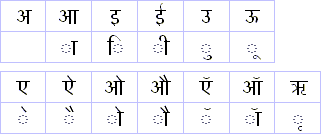3. MāŧrāEn̐ (Vowel-Signs)
As we have discussed, for every svar we have a mark or sign called māŧrā (मात्रा).
Plural of māŧrā is māŧrāEn̐ (मात्राएँ; matra/s).
These māŧrāEn̐ are applied over consonants to form syllables. To distinguish these māŧrāEn̐ from vowel modifiers we will call these as mukh'ya māŧrāEn̐. mukh'ya (मुख्य) means 'main' or 'prime'.
Some of these marks are applied above consonants, some are applied below consonants, some are applied before consonants, while rest are applied after the consonants. The māŧrāEn̐ which are applied after the consonants are the easiest as they follow normal pronunciation naturally.
A māŧrā which is applied before the consonants require care while writing manually. As computers can re-order characters in a syllable automatically hence we are required to type naturally, irrespective of where the matra is to be applied. BTW, there is only one such matra in ĐevaNāgarī - ि [chhotī I (ee) kī māŧrā].
In the following figure you can see svar/s (vowels and diphthongs) and their respective māŧrāEn̐. The dotted circles are just placeholders for base-letters (consonants). These dotted circles are only drawn by computers, so we can understand/see the relative position of these māŧrāEn̐.

For every vowel (except 'a') and diphthong we have a separate matra in ĐevaNāgarī.
To pronounce two consonants (of a word) separately we need at least one vowel between them!
Every consonant of ĐevaNāgarī has inherent vowel 'a'. So when we simply write consecutive consonants in a word, we pronounce 'a' in-between these consonants.
Eg. 'कम' (Akṣhar-ka Akṣhar-ma) is pronounced as 'kam' (similar in pronunciation to English word 'come'). In ĐevaNāgarī the last 'a' is not pronounced, so we don't pronounce 'कम' as 'kama'!
When we apply a māŧrā to a consonant, the inherent svar 'a' (schwa) is dropped and the vowel related to the māŧrā is pronounced. So if we apply a māŧrā 'ु' (māŧrā-u) on 'क' (Akṣhar-ka) and write a word 'कुम' (Akṣhar-ka māŧrā-u Akṣhar-ma) then we pronounce this word as as 'kum'.
We generally remember which māŧrā is applicable in a spelling! But even if we don't remember we can generally apply a proper māŧrā, after a bit of practice! We need to be a bit careful while using either ि [chhotī Ī (ee) kī māŧrā] or ी [baḍī EE kī māŧrā] and while using either ु [chhote U kī māŧrā] or ू [baḍe OO kī māŧrā].
To understand how MāŧrāEn̐ (Māŧrā/s) are applied base consonants see the article: how to type.
>> Click here to continue reading about chihn/as (चिह्न, signs, marks) of Nāgarī...
Please enter your email and click 'Recommend It' to receive the address of this page and related pages in your inbox. You can then send this page to your friend(s).